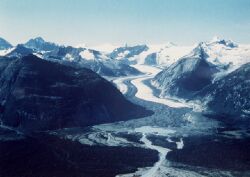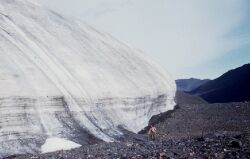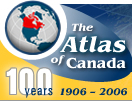|
Canada is a vast country comprised of a multitude of very different
landscapes. In the east, the rocks of the Atlantic provinces have
been sculpted by the ocean. With an area of 5660 square kilometres,
Prince Edward Island is Canada’s smallest province. Its flat-lying
topography reaches a maximum elevation of 142 metres. After millions
of years of erosion by winds and glaciers, the mountains of Atlantic
Canada have become gently rolling hills with flattened summits.
They now form the plateaus of the island of Newfoundland, the Caledonia
Mountains, the interior plateau of New Brunswick, the highlands
of Cape Breton, and other areas of Nova Scotia, all with elevations
ranging from 150 to 800 metres.
 [D] [D]
Click for more information, 14 KB
Aspy Bay , Cape Breton Island, Nova Scotia
Stretching from the Gaspé through the Estrie region of Quebec and
into the United States, the Appalachians reach elevations in excess
of 1000 metres. The Chic Choc Mountains represent the extension
of the Appalachians into the Gaspé and reach elevations of approximately
1200 metres.
The St. Lawrence and Great Lakes lowlands open westward in a wide
expanse of flat-lying land mainly between Quebec City and Lake Huron.
Over most of this area, the maximum elevation is under 300 metres.
The northern boundary of the St. Lawrence and Great Lakes lowlands
is the Canadian Shield. It covers nearly half of Canada roughly
in a giant horseshoe around Hudson Bay. In the west (such as in
Saskatchewan and the Northwest Territories), the Shield attains
average elevations of about 300 metres above sea level. The Shield
reaches higher elevations in the Haliburton Highlands of Ontario
and the Laurentian Mountains of Quebec, as well as along the Gulf
of St. Lawrence, in Labrador and on Baffin Island. The mountains
of the Labrador-Quebec border reach elevations of 1600 metres, while
those of Baffin Island rise as high as 2000 metres. The Shield has
two distinct types of landscapes: vast forests dotted by countless
lakes, and rolling treeless areas further north.
The Prairies stretch across the west-centre of Canada, crossing
through Manitoba, Saskatchewan and Alberta. From east to west across
this broad plain, elevations rise gradually, increasing by more
than 700 metres.
West of the Prairies, the mountain ranges and high plateaus of
the Canadian Cordillera occupy British Columbia and almost all of
the Yukon. Here, the many sharp peaks are topped by alpine glaciers
and draped in a year-round mantle of snow. The Yukon’s Mount Logan,
Canada’s highest peak, dominates the landscape from atop its lofty
5959 metres. Between the Coast Mountains, which border the entire
Pacific shore, and the Rockies lies a band of broad plateaus (the
Fraser Plateau, the Stikine Plateau and a rugged central zone) that
is several hundreds of kilometres in width. Along the Pacific shore,
the Coast Mountains are cut by broad, steep fiords, and the ocean
is dotted by a chain of islands of which the most important are
Vancouver Island and the Queen Charlotte Islands.
 [D] [D]
Click for more information, 9 KB
Flood glacier in the Boundary Ranges of the Coast Mountains, British Columbia
Northern Canada, for its part, has many faces, ranging from the very mountainous islands of the eastern
Arctic to the plain of the Mackenzie Delta in the west. Baffin, Victoria and Ellesmere are the largest of the
Arctic islands. Ellesmere island is the most northerly land mass reaching to within 800 kilometres of the
North Pole.
 [D] [D]
Click for more information, 10 KB
Superposed layers of rock, Victoria Island, Northwest Territories
 [D] [D]
Click for more information, 7 KB
Snout of glacier, Ellesmere Island
|
